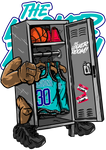
Digitzing (Embroidery Files)
Embroidery digitizing is the process of converting an image or design into a digital embroidery file that can be read by an embroidery machine. This digital file contains instructions for the machine to create intricate stitches and patterns using different colored threads on fabric. Embroidery digitizing is a crucial step in modern embroidery production, allowing for the replication of complex designs with high precision and efficiency.
Here's how the process typically works:
-
Design Creation: A design or logo is created by a graphic designer using specialized software. This design can include various elements like text, shapes, and intricate patterns.
-
Digitization: The design is then converted into a digital format that an embroidery machine can understand. This involves breaking down the design into individual stitches, specifying thread colors, stitch types (such as satin stitches, fill stitches, and outline stitches), and the order in which the stitches are sewn.
-
Digitizing Software: Specialized embroidery digitizing software is used for this step. The digitizer assigns various attributes to each part of the design, dictating how the machine will stitch the design.
-
Stitch Path: The digitizer defines the stitch path, which determines the sequence in which the machine will create the stitches. This is important to ensure that stitches are laid down efficiently and that the design looks accurate.
-
Thread Colors: The digitizer selects the appropriate thread colors based on the design's requirements. This information is embedded in the digital file.
-
Density and Underlay: The digitizer adjusts the density of stitches and adds underlay stitches to stabilize the fabric and create a smooth surface for the final design.
-
File Export: Once the digitizing process is complete, the design is saved in a specific embroidery file format, such as .DST, .PES, .EMB, etc. These formats are compatible with various brands of embroidery machines.
-
Embroidery Machine: The digital file is then loaded into an embroidery machine. The machine reads the file and follows the instructions to stitch the design onto the fabric.
Embroidery digitizing requires a combination of artistic skills and technical expertise. A skilled digitizer understands the limitations and capabilities of embroidery machines and software, ensuring that the final embroidered design closely matches the original artwork. The quality of digitizing directly impacts the appearance and durability of the embroidered design, making it a critical aspect of the embroidery production process.


